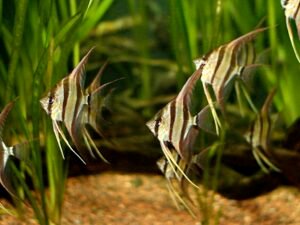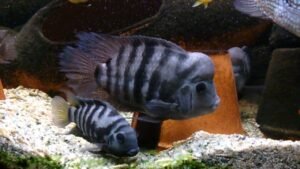The 10 Easiest Freshwater Aquarium Fish to Breed: A Guide for Beginner Aquarists

Convict Cichlids: The Jailbird of the Aquarium World
Simple and Rewarding: Breeding the Most Accessible Freshwater Fish
Breeding freshwater aquarium fish can be a rewarding and educational experience, especially for beginner aquarists. Some species are known for their ease of breeding, requiring minimal special conditions or care. This article explores the ten easiest freshwater fish to breed, making it accessible for hobbyists of all skill levels to enjoy the process of fish reproduction.
1. Guppies (Poecilia reticulata)
Why It’s Easy
- Livebearers: Guppies give birth to live young, eliminating the need to manage eggs.
- Hardy: They thrive in a variety of water conditions and are highly adaptable.
Breeding Process
Simply keeping male and female guppies together usually results in breeding. Females can give birth to dozens of fry every month. Providing plenty of plants or hiding places will help protect the fry from being eaten by adult fish (Aquarium Source).
2. Platies (Xiphophorus maculatus)
Why It’s Easy
- Livebearers: Like guppies, platies give birth to live young.
- Easy to Care For: They are hardy and do well in various water conditions.
Breeding Process
Keeping males and females together typically results in frequent breeding. Females can produce a large number of fry, which should be separated or provided with hiding spots to avoid predation (Fishkeeping World).
3. Mollies (Poecilia sphenops)
Why It’s Easy
- Livebearers: Mollies give birth to live young, making the breeding process straightforward.
- Adaptable: They can tolerate a range of water conditions and are easy to care for.
Breeding Process
Mollies breed readily when kept in groups with both males and females. They produce a large number of fry, which can be raised in the same tank with adequate hiding places (Aquarium Source).
4. Swordtails (Xiphophorus helleri)
Why It’s Easy
- Livebearers: Swordtails give birth to live young, simplifying the breeding process.
- Hardy: They are resilient and adaptable to various water conditions.
Breeding Process
Swordtails breed easily when males and females are kept together. They produce numerous fry, which benefit from having plants or decorations to hide in to avoid being eaten (Fishkeeping World).
5. Betta Fish (Betta splendens)
Why It’s Easy
- Bubble Nest Builders: Male bettas build bubble nests for their eggs, simplifying care.
- Frequent Breeders: Bettas are eager breeders with minimal prompting.
Breeding Process
Male bettas build a bubble nest on the water’s surface, and after courtship, the female deposits eggs into the nest. The male guards the nest until the fry hatch. Separate the female after spawning to prevent aggression (Betta Fish Center).
6. Zebra Danios (Danio rerio)
Why It’s Easy
- Hardy: Zebra danios are tolerant of a wide range of water conditions.
- Prolific Breeders: They spawn frequently and in large numbers.
Breeding Process
Zebra danios scatter eggs freely. Providing a breeding tank with marbles or a mesh bottom helps protect the eggs from being eaten. Remove adults after spawning to ensure higher survival rates of the fry (Aquarium Source).
7. Convict Cichlids (Amatitlania nigrofasciata)
Why It’s Easy
- Parental Care: Both parents care for the eggs and fry, increasing survival rates.
- Hardy: They adapt well to various water conditions.
Breeding Process
Convict cichlids are very easy to breed. They lay eggs on a flat surface, and both parents guard the eggs and fry. Providing hiding places helps reduce stress (Fishkeeping World).
8. Corydoras Catfish (Corydoras spp.)
Why It’s Easy
- Hardy: Corydoras are adaptable and resilient.
- Group Spawners: They breed in groups, increasing the likelihood of successful spawning.
Breeding Process
Corydoras often breed after a large water change. They lay adhesive eggs on surfaces such as glass or plants. Remove the adults after spawning to protect the eggs (Aquarium Source).
9. Cherry Barbs (Puntius titteya)
Why It’s Easy
- Peaceful: Cherry barbs are easy to care for and non-aggressive.
- Frequent Spawners: They spawn readily in a well-maintained tank.
Breeding Process
Cherry barbs scatter their eggs among plants. Using a breeding tank with a mesh or marbles helps protect the eggs. Remove adults after spawning to ensure the safety of the fry (Fishkeeping World).
10. Endler’s Livebearers (Poecilia wingei)
Why It’s Easy
- Livebearers: Endler’s livebearers give birth to live young.
- Hardy: They are adaptable and easy to care for.
Breeding Process
Endler’s livebearers breed readily when males and females are kept together. They produce a large number of fry, which should be provided with plants or hiding spots to avoid predation (Aquarium Source).
Conclusion
Breeding these easy freshwater fish species can be a rewarding and educational experience for aquarists of all skill levels. With minimal special conditions and straightforward care requirements, these species offer a great introduction to fish breeding. Enjoy the process of witnessing new life in your aquarium and contributing to the sustainability of these beloved species.
For more detailed guides and tips, visit:
Health and Disease Management: Tips for Maintaining Fish Health and Managing Common Diseases
Health and Disease Management: Tips for Maintaining Fish Health and Managing Common Diseases
Ensuring the Health and Well-Being of Your Aquarium Fish Maintaining the health of your aquarium...
Saltwater vs. Freshwater Aquariums: Weighing the Pros and Cons
Understanding the Differences Between Saltwater and Freshwater Aquariums Choosing between a saltwater and freshwater aquarium...
Top Freshwater Fish for Beginners: Highlighting Hardy and Easy-to-Care-for Fish Species
Discover the Best Freshwater Fish for Novice Aquarists Entering the world of fishkeeping can be...
Sustainable Fishkeeping: Embracing Eco-Friendly Practices in the Aquarium Hobby
Transforming the Aquarium Hobby with Sustainable Fishkeeping Practices Introduction As environmental awareness grows, the aquarium...
The 10 Easiest Freshwater Aquarium Fish to Breed: A Guide for Beginner Aquarists
Simple and Rewarding: Breeding the Most Accessible Freshwater Fish Breeding freshwater aquarium fish can be...
The 10 Most Difficult Freshwater Aquarium Fish to Breed: Challenges and Strategies for Advanced Aquarists
Overcoming the Challenges of Breeding the Most Complex Freshwater Aquarium Fish Breeding freshwater aquarium fish...
Views: 16











